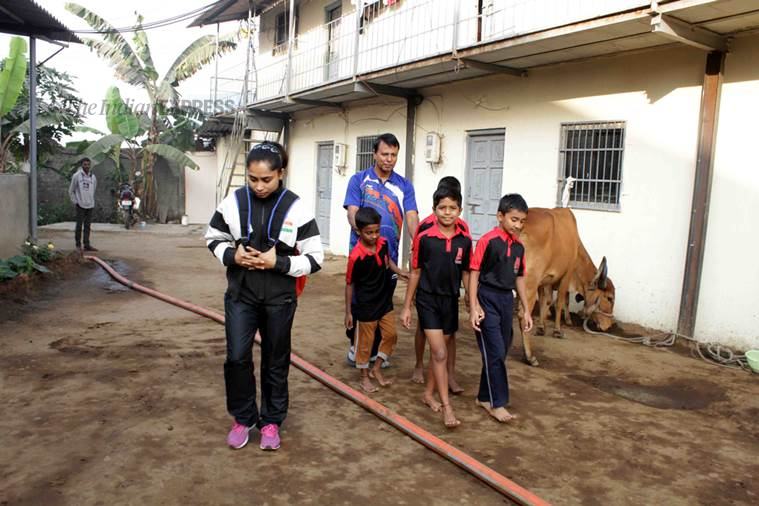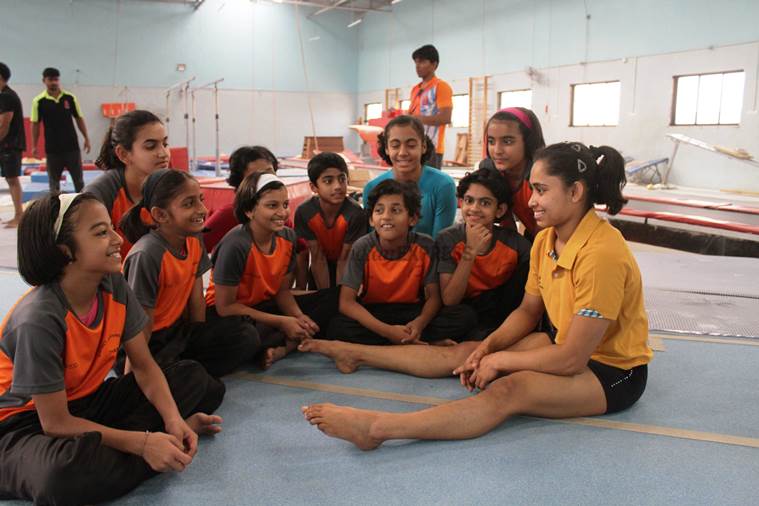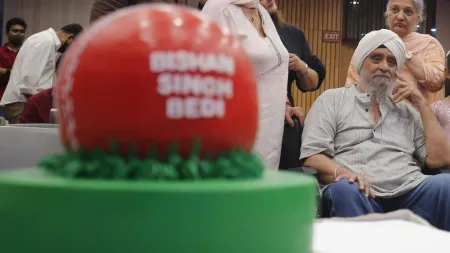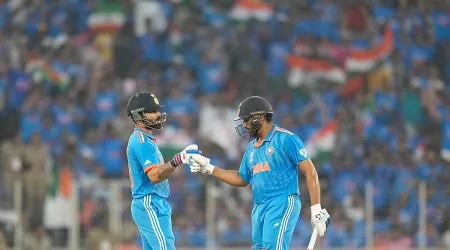- India
- International
Dipa Karmakar gunning for Tokyo via Bapgaon
The Indian Express visits a private gymnasium in a bucolic setting on the outskirts of Bhiwandi, Maharashtra, that is helping Dipa Karmakar perfect her moves ahead of Olympic qualifiers.
 Dipa Karmakar is camped in Bapgaon for three weeks starting January 1, and is relishing, amongst other things, clean air and a pared-down lifestyle, fresh, unadulterated cow milk. (Express Photo by Deepak Joshi)
Dipa Karmakar is camped in Bapgaon for three weeks starting January 1, and is relishing, amongst other things, clean air and a pared-down lifestyle, fresh, unadulterated cow milk. (Express Photo by Deepak Joshi)
Nadia, Kenzo and Uchimura are not as deft as Dipa Karmakar on this hazy, idyllic morning. Even when the sun breaks into a warm glow, there isn’t much of a response from the trio. Named after three of the most accomplished gymnasts Nadia Comaneci, Kenzo Shirai and Kohei Uchimura, the three cows sit in their shed and moo and chew — repetitions as earnest as Dipa’s front flips and back dives on the balance beam, but not even a fraction energetic. Ambitiously named, they nevertheless play their part in what has been the biggest arrival at the Aakar Gymnasium training centre in Bapgaon, bordering Kalyan and Bhiwandi along river Ulhas.
 Dipa’s coach Bisweshwar Nandi wanted a change of scene for her besides warmer weather — and no distractions as she started a new season. (Express Photo by Deepak Joshi)
Dipa’s coach Bisweshwar Nandi wanted a change of scene for her besides warmer weather — and no distractions as she started a new season. (Express Photo by Deepak Joshi)
Dipa Karmakar is camped here for three weeks starting January 1, and is relishing, amongst other things, clean air and a pared-down lifestyle, fresh, unadulterated cow milk. Swapping a city hotel or a rented apartment in Mumbai or Kalyan and eschewing basic comforts, Dipa has taken accommodation in a tiny but tidy room of a two-storey village home, because the adjoining Aakar Gymnasium has got its fundamentals right — a tunnel pit bursting with foams that surrounds her with cushioning safety as she polishes her movements. And German-make Spieth equipment; incidentally the preferred apparatus when she heads to the first of Olympic qualification tournaments at Doha in March.
“Before going to the Germany World Cup last November, Sir (her coach Bisweshwar Nandi) had promised me that if I return with a medal, he will take me outside for training. While that was proving to be very expensive, we couldn’t continue in Delhi (IG Stadium) as the pit hall has no heater,” Dipa says. She had heard about the Aakar Gymnasium — the first-ever fully equipped training centre in India, built privately by the Shinde family an hour and a half away from the Mumbai airport along the Nashik highway. 23-year-old Abhijit Shinde, for whom it got built, has been Dipa’s national camp-mate for many years. On Christmas eve, Nandi would call up Shinde and inform him that the coach-gymnast duo would train at this sleepy oasis, back of beyond, for the next fortnight and more.
“She is very happy and peaceful here. We come from Agartala, so all big cities are foreign to us. We don’t mind the simple living. This feels more familiar. After 40 years I’m seeing pure cow milk, unmixed with water and pure ghee! She is enjoying the healthy, organic food grown on the farm here, but most importantly, this centre has the best elite equipment for training of basic movements in India,” Nandi adds.
 Deepa Karmakar quickly settled into a routine away from the bustle of a Delhi camp, where gossip and intrigue in this chaotic sport, run rife. (Express Photo by Deepak Joshi)
Deepa Karmakar quickly settled into a routine away from the bustle of a Delhi camp, where gossip and intrigue in this chaotic sport, run rife. (Express Photo by Deepak Joshi)
The coach wanted a change of scene for Dipa besides warmer weather — and no distractions as she started a new season. “There were 2-3 new routines on the floor exercise that we managed to add to her skills, and she’s achieving confidence in perfecting the handspring 540-degree turn-somersault — the first of her two vaults in the last three weeks. These things need repetitions on a foam-pit, and we got excellent, undisturbed practice here,” the coach says.

Dipa has kept the dangerous Produnova routine oiled in its deconstructed format, but doesn’t intend to fully focus on it till the March qualifiers. The Handspring-540 and Tsukahara-720 will travel with her to Baku and Doha, though Dipa is looking sharp after a year spent in rehab after her knee surgery. This Mumbai outback is providing Dipa enough inconspicuousness, even if the outer grey facade of the hall — it barely has a nameplate, and the floor in the courtyard outside leading to her room is coated in dried cowdung — offers no indication of what is the most sophisticated equipment inside.
***
Kalyan was once Shivaji’s ace ship-building centre, and boasts some British-era bungalows as well as India’s first female doctor Dr Anandibai Joshi. While it’s attempting to grow into a University town for those not wishing to hike upto Mumbai, tourists are dragged to a preserved low-seat on which Peshwa Bajirao was rumoured to have gotten married, and a mansion that was supposed to house a Subedar’s daughter-in-law, like a 17th century Rapunzel. Fresh fruit and vegetable produce are ferried over the busy highway, dropped into the market — ‘mandai’. And while Thane has a throbbing sports culture, Kalyan has been known for its ‘houd kusti’ — wrestlers lowered into large tanks that were mud pits as spectators watched from a vantage. It has its brushes with history, but it might not have been what the renowned Gymnastics’ hall designer from Germany — Thierry Deleuze had imagined. Neighbouring Bhiwandi — a cotton mill town that Dhirubai Ambani frequented — is known for its industry, with political bigwigs snapping up land. But Bapgaon sits footlingly on the edge of obscurity.
Abhijit Shinde was on the periphery of India’s men’s gymnastics squad for the last few years and even travelled to Germany and China as part of national training camps. A bad dismount after an ACL injury left the Dombivali lad depressed for months. As a 4-year-old, his parents Pushpa and Eshwar, farmers from rural Jalgaon who had been living in the metropolitan suburb, had dropped him off at Bhoir Gymkahana because he was a particularly chubby kid. He had cracked the Indian team in 2014, even while pursuing mechanical engineering. “I saw what a difference good equipment could make,” Abhijit says. “After my injury, I was very down and told my father to set up two apparatus — rings and parallel bars — because I wanted to prove I could win a medal for India. They sold 25 acres of their farms and bought land in Bapgaon,” he recalls.
Eshwar had been a self-taught wrestler, who’d joined the police, risen to rank of inspector and then after clearing state civil services, changed departments. He had believed in the ability of sport to turn around an entire life, and seeing both sons — Abhijit and Omkar obsessed with gymnastics, had staked his all, to build a facility on the land he’d bought.
“My relatives and a few other parents of gymnasts chipped in. Abhijit had networked in Germany, and we decided to raise an entire training centre,” he recalls, adding that the prospect of paying off loans didn’t deter him.
“I had two options — go train abroad, or build this here,” Abhijit says. “I thought this would help many more people. It was the only topic of discussion in the house for two years — it was crazy, but that was the only thing that could help me — having a centre with equipment of my own.” A truckful of workers — 35 — came down from Jalgaon and first built the 22-28 feet high hall. Maharashtra isn’t too shabby at gymnastics, but the state never really took off internationally and stayed limited in its ambition.
While procuring the German-make equipment could not be compromised, the Shindes would go about improvising on other fillers.
The all-important filler in gymnastics is the foam-pit — a trench filled with sponges that cushion the fall after risky repetitions. But it can cost upto a crore. Getting one in Delhi for the official camp had cost a bomb, and even the best of gymnastics centres — in UP, Bengal or Tripura and Balewadi in Pune — are still making do with equipment wheeled in when hosting multi-sport Games, some even from Asiad of 1982. Spieth would lend Abhijit an old chemical formula for the sponges, and he would seek out 15-20 foam-mattress makers across India to plead with them to make the 100x200mm foam blocks. 10 trucks would roll in to fill the tunnel shafts at Aakar Centre that run the length of the hall and offer a safety net for every apparatus.
The non-descript Bapgaon had never seen anything like this before. This swathe of land had been sparsely forested and cycling and cross-country teams of Railways would often use the bypass for their training. The Gandhari bridge that connects Kalyan to this village had been washed away in the 26/7 floods of 2005, but the roads had been done up, and a helipad had come up recently when some celebrities had air-dropped. Eshwar Shinde had nudged the electricity provider to pitch up poles along this path to light up the village, and a borewell had been dug earlier in 2016. The Shindes had stopped watching television a decade ago when the children were appearing for boards, and an old TV was hauled into the barely pucca house only because Dipa was arriving here.
While she would have her meals —wholesome bhaaji, usal, koshimbir, bhakri and a rural recipe of chicken — in a large steel thaali, Dipa had begun enjoying her routine of post-practice baths, with water heated on a firewood chulha.
“It’s peaceful and I’m liking the food with no milaawat. I see where it’s grown, and where the cows are milked, and I’m happy to live here because what matters to me — the gymnastics equipment — is perfect,” Dipa says.
***
 The non-descript Bapgaon had never seen anything like this before. (Express Photo by Deepak Joshi)
The non-descript Bapgaon had never seen anything like this before. (Express Photo by Deepak Joshi)
Raising the centre wasn’t without its share of headaches that went beyond cobbling up the enormous money and staggering the loans repayment. Welding machines and construction material got stolen in early months. While the German designer Deleuze had flown down to take a look and plan every corner meticulously following it up on Skype, Abhijit would arrive every weekend and declare repairs were needed to the hassled workers. “We’d never known G of gymnastics before our son started in the sport,” says Pushpa, “so we wouldn’t understand why he’s fussing about half an inch here and there. We were trying to save money, but he would come and break down everything, and rebuild again,” she recalls laughing, sympathising with the carpenter.
“Gymnastics is about decimal scores. Thierry has designed many training halls and taught me to be exact. When he came he brought laser equipment for precise measurement, and checked every nail and nut-bolt. We can’t offer luxury in staying quarters, but I knew my training centre had to be perfect in equipment and totally safe,” Abhijit says.
Japanese coaches would come down last year, holding train-the-trainers programmes. “Both them and Thierry would come here, insist on staying at the house attached to the centre, eat spicy chicken and refuse hotel food,” Pushpa says. The Japanese would go away happy with a crate of mangoes, while the Germans asked for 25 kg of basmati rice as barter for the expertise (above the cost, of course) — which became an almighty headache for Eshwar, after the government banned export of a certain brand.
Soon, coaches from across the state would start availing the facilities for short 10-day camps, attempting routines they had never dared to before — emboldened by the foam-pit and even aerial harnesses. Meanwhile the Shindes would request the owner of the neighbouring plot to allow them to cultivate a vegetable patch — growing all they needed close to the kitchen, and cutting down entirely on processed food.
 Aakar centre offered Dipa a calm mind to stitch up her routines. (Express Photo by Deepak Joshi)
Aakar centre offered Dipa a calm mind to stitch up her routines. (Express Photo by Deepak Joshi)
Dipa would arrive at dawn on New Year’s Day and quickly settle into a routine away from the bustle of a Delhi camp, where gossip and intrigue in this chaotic sport, run rife. There’s more tangles in inter-personal equations than of the limbs in Indian gymnastics, and Aakar centre offered Dipa a calm mind to stitch up her routines. There was enough time and freedom to go through repetitions without verbal darts flying around and she could retire to her room literally five steps outside the hall for a breather.
When the hall was up and after the equipment was fitted in, finally waltzed in the trio of Nadia, Kenzo and Uchimura.“I grew up drinking raw cow milk and built my wrestling on that. I feel bad that kids now are only fed milk that’s mixed with other things. So we got our milch cows. My son is obsessed with gymnastics. So he’s named everything after gymnasts,” Eshwar says. Dipa’s keeping illustrious company this last month; though she chuckles that she worships the real Nadia, the human one.










































